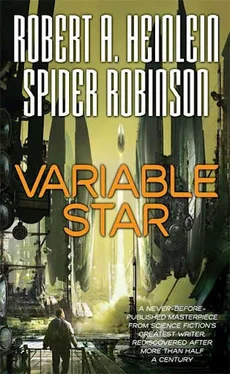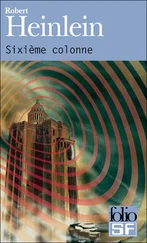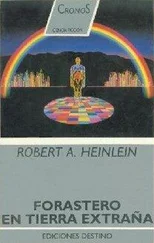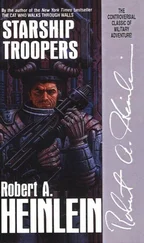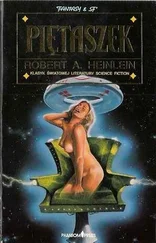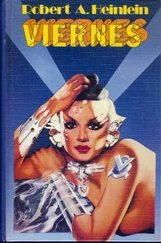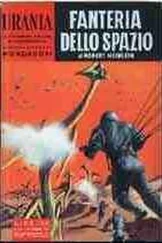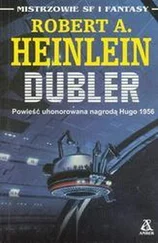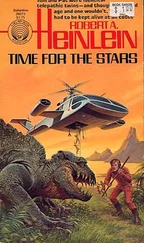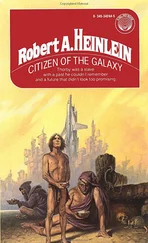Nor will I ever forget the love and support of David Crosby, who gave me the chords and melody for “On the Way to the Stars”—not to mention the 1.67gHz G4 Powerbook on which Variable Star was researched and written. The music I listened to most often while I wrote was that of CPR, the band David and his older son James Raymond formed with Jeff Pevar ( www.crosbycpr.com ), and also the landmark 2004 Crosby•Nash double-album.
Numerous others also furnished invaluable ideas and insights, including Bob Atkinson, John Barnstead, Bill Patterson, Eleanor Wood, David Gerrold, Jef Raskin, Michael Lennick, James Gifford, Paul Hattori, Yoji Kondo, Herb Varley (who suggested the Mercury be powered by hyperphotonic swans), my editor Pat LoBrutto, and doubtless others I’m blanking on now. I hope they’ll forgive me.
And nobody’s input was more valuable or more profoundly appreciated than that of my beloved wife and partner, Jeanne, who read each day’s copy when she woke up, and left extensive notes on my keyboard for me to find every night when I went to work; no one will ever suspect how many stupid mistakes she caught before anyone else got to see them, or how many neat ideas were really hers.
Once the story was complete, everybody named went over it looking for mistakes, misunderstandings, and problems, and then helped me repair them. So—crucially for my peace of mind—did my friends John Varley and David R. Palmer, both noted Heinlein experts, who went over the manuscript with great care and each made characteristically astute suggestions.
To all these people I give my deepest thanks. As always, any mistakes are my fault.
But it takes more than just technical advice to finish a novel. Especially this one.
First of all, and last of all, I want to say that without Jeanne’s boundless love and rock-solid support, I would never have even dreamed of starting such a nerve-wracking project, and would probably have finished it, if I did, with a massive dependency on Ativan, or worse. She is my invariable star, and our orbit is stable. Equally invaluable were the unquestioning love and sensible advice of our remarkable daughter Terri Luanna, both an advertising exec and a social worker in the toughest town on Terra.
Art Dula took a major weight off my shoulders right from the start, by telling me, “I do not want you to try and do the literary equivalent of a Rich Little impression of Robert Heinlein. I want you to take his outline and write the best damn Spider Robinson novel you’re capable of.” He also gifted me with Robert’s own, many-times-hand-repaired desk dictionary. I had Robert Heinlein’s personal box of words to dip into, any time I ran short of them—and still do. Thank you, Art.
A mainstay of my morale throughout was Robert and Ginny’s granddaughter, Dr. Amy Baxter, M.D. Jeanne and I met her and her husband, Louis Calderon, M.D., at Torcon 3, two nights before I sat on that panel and learned of the existence of an unwritten Heinlein novel, and we hit it off immediately. When she learned I had landed the commission, Amy promptly sent me a pair of her grandfather’s Polynesian cuff links to wear as I typed, and sent Jeanne some of Ginny’s jewelry to wear for me. (I was startled and amused to discover that it was necessary to send one of my shirts out to a tailor and have it retrofitted to accept cuff links—apparently they stopped having them while I wasn’t looking.) By the time I was steaming into the home stretch of Variable Star in summer 2005, I was wearing Robert’s treasured, threadbare favorite gardening shirt as I wrote out in my office, and Jeanne was in the house, in her own office, wearing Ginny’s kimono. Bless you, Amy.
Other moral support and/or morale support (sometimes inadvertent or unsuspected) was provided by Daniel P. Gautreau, Alex Morton, Anya Coveney-Hughes, Andrea MacDonald, Greg McKinnon, Bob Atkinson, George R. R. Martin, Parris McBride, Alex Grey, Joe and Gay Haldeman, Lawrence Block, Tom Robbins, Robert Crais, Donald E. Westlake, Amos Garrett, Gregg Carroll, Holger Petersen, Paul Pena, Seth Augustus, Moses Znaimer, Keith Hensen, Paul Krassner, David, Jan and Django Crosby, James Raymond, Graham Nash, Jens Stark, Gabrielle Morrissette, Rob Bailey, Kerry Yackoboski, Damien Broderick, James R. Cunningham, Brad Linaweaver, Robin W. Bailey, Steve and Lynn Fahnestalk, Will Soto, Evita Karlic, the Heinlein Society, Charles, Mary, and Jim Robinson, innumerable kind members of the Usenet group alt.callahans, and whoever I’ve forgotten to mention.
Finally, all the Portuguese names for Brasil Novo and its moons were furnished by my son-in-law, Heron Gonçalves da Silva, of Niteroi, Brazil—a classic young Heinlein Hero if there ever was one, who came to New York a few years ago without a dime, a reference, or a word of English, and is now studying electrical engineering at the same university I got my own degree from. Obrigado, meu genro.
Writing Variable Star has involved more work, more pressure, more fear, and above all, more sheer fun than all my other books put together. I hope it will be given to me to write another thirty-three, but I doubt any of them will come close to this.
Every time I’ve ever sat down to write anything, I’ve had Robert looking over my shoulder, of course, because he is my first template for How This Thing Should Be Done. But this time around, I felt his presence far more powerfully than ever before. In general it had a calming effect.
Only twice did it actually get spooky.
The first time, I frightened my wife badly when she discovered me heading out to my office with the vacuum cleaner . She was vastly relieved to learn I was not going insane, but merely being haunted: in fact, she roared with laughter when I finally admitted that Robert had stubbornly insisted he was not going to work in that goddamn pigsty until I mucked the place out.
The second time, it was me who got the willies. A friend had sent me the URL for a particularly thrilling NASA Quicktime movie: a full 360-degree true-color view of the surface of Mars. (Google it for yourself.) I was mousing my way around in a circle in wild exhilaration, like a drunken dervish, intoxicated by what I was doing, thinking to myself how thrilled Robert would have been to see this. Check it out, Robert! I cried in my mind. A robot on the Red Planet, named after Miss Sojourner Truth! I’m sitting at my desk, using my mouse to pan around Mars, can you believe this?
Just then, I moused past a series of surface irregularities just odd enough to catch my eye: a string of roughly spherical depressions in the coppery sand, separated by intervals of about the same distance. I wondered idly what they were.
At that moment, I heard a voice—an actual, physically audible voice—the well-remembered, unmistakable Missouri voice of Robert Heinlein—say, I swear to you, these two words: “Willis tracks.”
Well, those bumps in the sand did indeed look just like the tracks that might be left by a Martian bouncer such as Willis, the star of Robert’s classic juvenile novel Red Planet, now that I thought about it. But I hadn’t been thinking about it. The hair stood up on the back of my neck, and I nearly crushed my mouse. If you’ll pardon the expression.
That is my only actual ghost story, I’m happy to say. And I admit I was not cold sober that night. Nonetheless, I report that from start to finish, writing Variable Star has left me feeling Robert’s presence and spirit far more strongly than I had since he caught a starship for parts unknown back in 1988.
I sincerely hope it has done the same for you.
—Bowen Island, B.C. 24 November, 2005
Books by Robert A. Heinlein
Читать дальше
